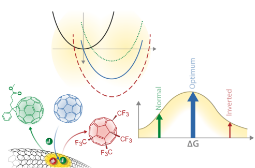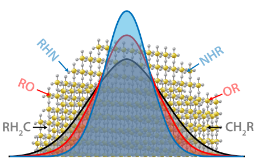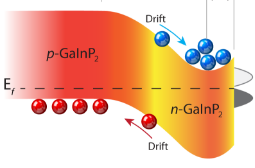Solar Photochemistry
NLR's solar photochemistry research focuses on solar photoconversion in molecular, nanoscale, and semiconductor systems to capture, control, and convert high-efficiency solar radiation into electrochemical potential for electricity, chemicals, or fuels.
Main Research Thrusts
Organic and Molecular Semiconductors
Acquiring a fundamental understanding of interfacial photoinduced electron transfer processes at molecular, nanoscale, and organic interfaces.
Quantum-Confined Semiconductors
Seeking to control the optical and electronic properties of quantum-confined semiconductors through doping—coupling of the core electronic structures to surface bound ligands or interactions with plasmotic nanoparticles to direct and transduce energy.
Photo and Electrochemical Redox Systems
Seeking to understand how chemical and physical structure affects the thermodynamics and kinetics of charge separation and redox chemistry in photo(electro)chemical systems.
Featured Publications
Ultrafast Charge Transfer Cascade in a Mixed-Dimensionality Nanoscale Trilayer, ACS Nano (2024)
Missing Excitons: How Energy Transfer Competes with Free Charge Generation in Dilute-Donor/Acceptor Systems, ACS Energy Letters (2024)
Controlling Exciton/Exciton Recombination in 2-D Perovskite Using Exciton–Polariton Coupling, The Journal of Physical Chemistry Letters (2024)
Membranes Matter: Preventing Ammonia Crossover During Electrochemical Ammonia Synthesis, ACS Applied Energy Materials (2024)
Using Spatial Confinement to Decipher Polymorphism in the Organic Semiconductor P-Dts(Fbtth2)2, Journal of Materials Chemistry C (2024)
Silicon Nanocrystal Hybrid Photocatalysts as Models to Understand Solar Fuels Producing Assemblies, Sustainable Energy & Fuels (2023)
Carrier Density and Delocalization Signatures in Doped Carbon Nanotubes from Quantitative Magnetic Resonance, Nanoscale Horizons (2023)
Porphene and Porphite as Porphyrin Analogs of Graphene and Graphite, Nature Communications (2023)
Multiexciton Quintet State Populations in a Rigid Pyrene-Bridged Parallel Tetracene Dimer, Chemical Science (2023)
Controlling Electronic Coupling of Acene Chromophores on Quantum Dot Surfaces through Variable-Concentration Ligand Exchange, ACS Nano (2023)
Metal–Carbodithioate-Based 3d Semiconducting Metal–Organic Framework: Porous Optoelectronic Material for Energy Conversion, ACS Applied Materials & Interfaces (2023)
Tuning Counterion Chemistry to Reduce Carrier Localization in Doped Semiconducting Carbon Nanotube Networks, Cell Reports Physical Science (2023)
Charge Concentration Limits the Hydrogen Evolution Rate in Organic Nanoparticle Photocatalysts, Advanced Materials (2023)
Chirality Dependence of Triplet Excitons in (6,5) and (7,5) Single-Wall Carbon Nanotubes Revealed by Optically Detected Magnetic Resonance, ACS Nano (2023)
Flexible 2d Boron Imidazolate Framework for Polysulfide Adsorption in Lithium–Sulfur Batteries, Chemistry of Materials (2022)
Amplitude-Mode Spectroscopy of Chemically Injected and Photogenerated Charge Carriers in Semiconducting Single-Walled Carbon Nanotubes, Nano Research (2022)
Molecular Functionalization of Semiconductor Surfaces, Springer Handbook of Inorganic Photochemistry (2022)
Arresting Photodegradation in Semiconducting Single-Walled Carbon Nanotube Thin Films, ACS Applied Nano Materials (2022)
Elucidating the Electronic Properties of Single-Wall Carbon Nanohorns, Journal of Materials Chemistry C (2022)
Dye-Sensitized Multiple Exciton Generation in Lead Sulfide Quantum Dots, Journal of the American Chemical Society (2022)
Ultrastrong Coupling of Band-Nested Excitons in Few-Layer Molybdenum Disulphide, Advanced Optical Materials (2022)
Pickering Emulsions of Self-Assembled Lead Sulfide Quantum Dots with Janus-Ligand Shells as Nanoreactors for Photocatalytic Reactions, ACS Applied Nano Materials (2022)
Ultrastrong Coupling Leads to Slowed Cooling of Hot Excitons in Few-Layer Transition-Metal Dichalcogenides, The Journal of Physical Chemistry C (2022)
Covalent Functionalization of Nickel Phosphide Nanocrystals with Aryl-Diazonium Salts, Chemistry of Materials (2021)
Competing Singlet Fission and Excimer Formation in Solid Fluorinated 1,3-Diphenylisobenzofurans, The Journal of Physical Chemistry C (2021)
Controlled N-Doping of Naphthalene-Diimide-Based 2d Polymers, Advanced Materials (2021)
Probing Activities of Individual Catalytic Nanoflakes by Tunneling Mode of Scanning Electrochemical Microscopy, The Journal of Physical Chemistry C (2021)
Interlayer Triplet-Sensitized Luminescence in Layered Two-Dimensional Hybrid Metal-Halide Perovskites, ACS Energy Letters (2021)
Atomlike Interaction and Optically Tunable Giant Band-Gap Renormalization in Large-Area Atomically Thin Mos2, Physical Review B (2021)
Evaluation of Nanostructured Β-Mn2v2o7 Thin Films as Photoanodes for Photoelectrochemical Water Oxidation, Chemistry of Materials (2021)
Exogenous Electricity Flowing through Cyanobacterial Photosystem I Drives Co2 Valorization with High Energy Efficiency, Energy & Environmental Science (2021)
Influence of Ligand Structure on Excited State Surface Chemistry of Lead Sulfide Quantum Dots, Journal of the American Chemical Society (2021)
In Situ Synthesis of Molybdenum Carbide Nanoparticles Incorporated into Laser-Patterned Nitrogen-Doped Carbon for Room Temperature Voc Sensing, Advanced Functional Materials (2021)
Solution-Phase P-Type Doping of Highly Enriched Semiconducting Single-Walled Carbon Nanotubes for Thermoelectric Thin Films, Applied Physics Letters (2021)
Enhancing Interfacial Charge Transfer in a Wo3/Bivo4 Photoanode Heterojunction through Gallium and Tungsten Co-Doping and a Sulfur Modified Bi2o3 Interfacial Layer, Journal of Materials Chemistry A (2021)
Resolving Electron Injection from Singlet Fission-Borne Triplets into Mesoporous Transparent Conducting Oxides, Chemical Science (2021)
Open Questions on the Photophysics of Ultrafast Singlet Fission, Communications Chemistry (2021)
Interlayer Triplet Energy Transfer in Dion–Jacobson Two-Dimensional Lead Halide Perovskites Containing Naphthalene Diammonium Cations, The Journal of Physical Chemistry Letters (2021)
Polyvinyl Acetate-Based Polymer Host for Optical and Far-Infrared Spectroscopy of Individualized Nanoparticles, Journal of Applied Physics (2021)
Hydrogen Bonding Optimizes Singlet Fission in Carboxylic Acid Functionalized Anthradithiophene Films, ChemPhotoChem (2021)
Ternary Sigesn Alloy Nanocrystals Via Nonthermal Plasma Synthesis, Journal of Physics D: Applied Physics (2021)
Carbon Dioxide and Nitrogen Reduction Reactions Using 2d Transition Metal Dichalcogenide (Tmdc) and Carbide/Nitride (Mxene) Catalysts, Energy & Environmental Science (2021)
Exciton–Phonon Coupling and Carrier Relaxation in Pbs Quantum Dots: The Case of Carboxylate Ligands, The Journal of Physical Chemistry C (2021)
Size-Dependent Janus-Ligand Shell Formation on Pbs Quantum Dots, The Journal of Physical Chemistry C (2021)
Pyroelectricity of Lead Sulfide (Pbs) Quantum Dot Films Induced by Janus-Ligand Shells, ACS Nano (2021)
Triplet Excitons in Pentacene Are Intrinsically Difficult to Dissociate via Charge Transfer, Journal of Physical Chemistry C (2021)
Stabilizing the Heavily-Doped and Metallic Phase of MoS2 Monolayers With Surface Functionalization, 2D Materials (2021)
Short and Long-Range Electron Transfer Compete To Determine Free-Charge Yield in Organic Semiconductors, Materials Horizons (2021)
Reconciling the Driving Force and the Barrier to Charge Separation in Donor–Nonfullerene Acceptor Films, ACS Energy Letters (2021)
Interplay Between Microstructure, Defect States, and Mobile Charge Generation in Transition Metal Dichalcogenide Heterojunctions, Nanoscale (2021)
Linking Optical Spectra to Free charges in Donor/Acceptor Heterojunctions: Cross-Correlation of Transient Microwave and Optical Spectroscopy, Materials Horizons (2021)
Mechanisms of Hydrogen Evolution Reaction in Two-Dimensional Nitride MXenes Using In Situ X-Ray Absorption Spectroelectrochemistry, ACS Catalysis (2021)
Suppressing Auger Recombination in Multiply Excited Colloidal Silicon Nanocrystals With Ligand-Induced Hole Traps, The Journal of Physical Chemistry C (2021)
Using Carbon Laser Patterning to Produce Flexible, Metal-Free Humidity Sensors, ACS Applied Electronic Materials (2020)
Nanotechnology for Catalysis and Solar Energy Conversion, Nanotechnology (2020)
Spatially Resolved Persistent Photoconductivity in Mos2–Ws2 Lateral Heterostructures, ACS Nano (2020)
Reversible Multicolor Chromism in Layered Formamidinium Metal Halide Perovskites, Nature Communications (2020)
Size- and Temperature-Dependent Suppression of Phonon Thermal Conductivity in Carbon Nanotube Thermoelectric Films, Advanced Electronic Materials (2020)
Strategic Design of Moo2 Nanoparticles Supported by Carbon Nanowires for Enhanced Electrocatalytic Nitrogen Reduction, ACS Energy Letters (2020)
Transient Evolution of the Built-in Field at Junctions of Gaas, ACS Applied Materials & Interfaces (2020)
Monitoring Local Electric Fields Using Stark Shifts on Napthyl Nitrile-Functionalized Silicon Photoelectrodes, The Journal of Physical Chemistry C (2020)
Applying Dynamic Strain on Thin Oxide Films Immobilized on a Pseudoelastic Nickel-Titanium Alloy, JoVE (Journal of Visualized Experiments) (2020)
Improving Efficiency and Stability of Perovskite Solar Cells Enabled by a near-Infrared-Absorbing Moisture Barrier, Joule (2020)
Photoinduced Charge Transfer in Transition Metal Dichalcogenide Heterojunctions – Towards Next Generation Energy Technologies, Energy & Environmental Science (2020)
Progress and Prospective of Nitrogen-Based Alternative Fuels, Chemical Reviews (2020)
Conversion Between Triplet Pair States Is Controlled by Molecular Coupling in Pentadithiophene Thin Films, Chemical Science (2020)
Bodipy Based a-D-a Molecules: Effect of Cf3 Group Substitution at Meso Phenyl Group, Dyes and Pigments (2020)
Plasmon-Mediated Coherent Superposition of Discrete Excitons under Strong Exciton–Plasmon Coupling in Few-Layer Mos2 at Room Temperature, ACS Photonics (2020)
Dynamic Ligand Surface Chemistry of Excited Pbs Quantum Dots, The Journal of Physical Chemistry Letters (2020)
Transforming Energy Using Quantum Dots, Energy & Environmental Science (2020)
Energetic Tug-of-War between Pt and Leaky Tio2: Positive and Negative Effects on the Function of Molecularly-Modified P-Si(111)|Tio2|Pt Photocathodes, ChemElectroChem (2020)
Control of Quantum Dot Emission by Colloidal Plasmonic Pyramids in a Liquid Crystal, Optics Express (2020)
Interference Provides Clarity: Direct Observation of 2d Materials at Fluid–Fluid Interfaces, ACS Nano (2020)
Lessons from Intramolecular Singlet Fission with Covalently Bound Chromophores, The Journal of Chemical Physics (2020)
Electronic States of 2,3-Diamino-1,4-Naphthoquinone and Its N-Alkylated Derivatives, The Journal of Physical Chemistry C (2020)
Practical Challenges in the Development of Photoelectrochemical Solar Fuels Production, Sustainable Energy & Fuels (2020)
Cation-Exchange Synthesis of Highly Monodisperse Pbs Quantum Dots from Zns Nanorods for Efficient Infrared Solar Cells, Advanced Functional Materials (2020)
Modulating Donor–Acceptor Transition Energies in Phosphorus–Boron Co-Doped Silicon Nanocrystals via X- and L-type Ligands, Faraday Discussions (2020)
Basal Plane Hydrogen Evolution Activity from Mixed Metal Nitride MXenes Measured by Scanning Electrochemical Microscopy, Adv. Funct. Mater. (2020)
Decoupling Kinetics and Thermodynamics of Interfacial Catalysis at a Chemically Modified Black Silicon Semiconductor Photoelectrode, ACS Energy Lett. (2020)
Measuring Photoexcited Free Charge Carriers in Mono- to Few-Layer Transition-Metal Dichalcogenides with Steady-State Microwave Conductivity, Journal of Physical Chemistry Letters (2020)
Spatial Separation of Triplet Excitons Drives Endothermic Singlet Fission, Nature Chemistry (2020)
Disentangling Oxygen and Water Vapor Effects on Optoelectronic Properties of Monolayer Tungsten Disulfide, Nanoscale (2020)
Hot-Carrier Transfer at Photocatalytic Silicon/Platinum Interfaces, J. Chem. Phys (2020)
Plasmonic Hot Hole Transfer in Gold Nanoparticle-Decorated Transition Metal Dichalcogenide Nanosheets, ACS Photonics (2020)
Unique Interfacial Thermodynamics of Few-Layer 2D MoS2 for (Photo)electrochemical Catalysis, Energy Environ. Sci. (2019)
Energetic Effects of Hybrid Organic/Inorganic Interfacial Architecture on Nanoporous Black Silicon Photoelectrodes, Sustainable Energy & Fuels (2019)
Nonthermal Plasma-Synthesized Phosphorus−Boron Co-Doped Si Nanocrystals: A New Approach to Nontoxic NIR-Emitters, Chem. Mater. (2019)
Electrocatalytic and Optoelectronic Characteristics of the Two-Dimensional Titanium Nitride Ti4N3Tx MXene, ACS Applied Materials & Interface (2019)
Designing Janus Ligand Shells on PbS Quantum Dots using Ligand–Ligand Cooperativity, ACS Nano (2019)
Dynamic Tuning of a Thin Film Electrocatalyst by Tensile Strain, Scientific Reports (2019)
Slow Charge Transfer from Pentacene Triplet States at the Marcus Optimum, Nature Chemistry (2019)
Carbon Nanotube Color Centers in Plasmonic Nanocavities: A Path to Photon Indistinguishability at Telecom Bands, Nano Lett. (2019)
Nanoscale Mapping of Hydrogen Evolution on Metallic and Semiconducting MoS2 Nanosheets, Nanoscale Horizons (2019)
Enhanced Multiple Exciton Generation in PbS|CdS Janus-like Heterostructured Nanocrystals, ACS Nano (2018)
n-type PbSe Quantum Dots via Post-Synthetic Indium Doping, J. Am. Chem. Soc. (2018)
Long-lived Charge Separation at Heterojunctions between Semiconducting SWCNTs and Perylene Diimide Electron Acceptors, J. Phys. Chem. C. (2018)
Tuning and Switching a Plasmonic Quantum Dot “Sandwich” in a Nematic Line Defect, ACS Nano (2018)
Morphological Control of InxGa1–xP Nanocrystals Synthesized in a Nonthermal Plasma, Chemistry of Materials (2018)
Tuning Confinement in Colloidal Silicon Nanocrystals with Saturated Surface Ligands, Nano Letters (2018)
Optical Absorbance Enhancement in PbS QD/Cinnamate Ligand Complexes, Phys. Chem. Lett. (2018)
Efficiency of Charge-Transfer Doping in Organic Semiconductors Probed with Quantitative Microwave and Direct-Current Conductance, Journal of Physical Chemistry Letters (2018)
Publications Database
Browse or search all NLR journal articles, conference papers, and reports about solar photochemistry.
Research Staff
Joshua Carr (CU-Boulder, Materials Science Engineering Program) – Exploring models for charge transfer of singlet excitons generated from sensitized donors in a small molecule accepting host and how solid-state microstructure affects this through ultrafast optical and microwave spectroscopy
Rao Fei (CU-Boulder, Physics) – Studying strong coupling on 2D materials with optical cavities and plasmonic nanocavities and other light-matter interactions on semiconductors with liquid crystals
Ben Feingold – Analyzing ligand exchange solutions that have interfaced with PbS quantum
dot-coated substrates
Ben Feingold ORCID ID
Alexis Myers (CU-Boulder, Chemistry) – Studying photoinduced charge transfer dynamics in 2D transition metal dichalcogenides for application in the development of novel transition metal dichalcogenides-based heterostructures
Nicholas Pompetti (CU-Boulder, Chemistry) – Synthesizing and investigating, through time-resolved spectroscopy, the behavior of novel acene derivatives in dye-sensitized solar cell architectures
Leo Romanetz (CU-Boulder, Chemistry) – Studying methods for detection of charge transfer
states in donor-acceptor organic semiconductor systems using photoinduced absorption
detected magnetic resonance spectroscopy
Leo Romanetz ORCID ID
Arthur Nozik – Serving as senior research fellow emeritus
Obadiah Reid – Understanding charge separation and transport in molecular semiconductors, global modeling of photochemical reaction dynamics, development and modeling of quantitative microwave conductivity instrumentation
Andrew Ferguson – Employing spectroscopic techniques to probe photogenerated and chemically injected charge carrier dynamics and transport in polymeric and nanocarbon semiconductor systems
Greg Pach – Studying nonthermal plasma synthesis of novel semiconductor nanomaterials for applications in photovoltaics, photochemical processes, and energy storage
Melissa Gish – Ultrafast spectroscopist studying photoinduced dynamics at semiconductor-molecule interfaces
Debjit Ghoshal – Synthesizing and manipulating optoelectronic properties of two-dimensional transition metal dichalcogenides by doping, strain engineering, and coupling with plasmons
Marissa Martinez – Using spectroscopic methods to study the structure, electronic, and energetic coupling of carboxylic acid functionalized chromophores on quantum dot thin films
Logan Wilder – Studying the (photo)electrocatalytic properties of transition metal dichalcogenides; working to improve the efficiency of electrosynthesis methods by controlling the morphology of the electrode/electrolyte interface and by introducing strain, defect sites, or heteroatoms into electrocatalysts
U.S. Department of Energy Support
This work is funded by the U.S. Department of Energy, Office of Science, Office of Basic Energy Sciences, Division of Chemical Sciences, Geosciences, and Biosciences, Solar Photochemistry Program.
Contact
Share
Last Updated Dec. 6, 2025



